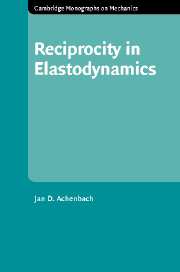Book contents
- Frontmatter
- Contents
- Preface
- 1 Introduction
- 2 Some elastodynamic theory
- 3 Wave motion in an unbounded elastic solid
- 4 Reciprocity in acoustics
- 5 Reciprocity in one-dimensional elastodynamics
- 6 Reciprocity in two- and three-dimensional elastodynamics
- 7 Wave motion guided by a carrier wave
- 8 Computation of surface waves by reciprocity considerations
- 9 Reciprocity considerations for an elastic layer
- 10 Forced motion of an elastic layer
- 11 Integral representations and integral equations
- 12 Scattering in waveguides and bounded bodies
- 13 Reciprocity for coupled acousto-elastic systems
- 14 Reciprocity for piezoelectric systems
- References
- Index of cited names
- Subject index
13 - Reciprocity for coupled acousto-elastic systems
Published online by Cambridge University Press: 10 December 2009
- Frontmatter
- Contents
- Preface
- 1 Introduction
- 2 Some elastodynamic theory
- 3 Wave motion in an unbounded elastic solid
- 4 Reciprocity in acoustics
- 5 Reciprocity in one-dimensional elastodynamics
- 6 Reciprocity in two- and three-dimensional elastodynamics
- 7 Wave motion guided by a carrier wave
- 8 Computation of surface waves by reciprocity considerations
- 9 Reciprocity considerations for an elastic layer
- 10 Forced motion of an elastic layer
- 11 Integral representations and integral equations
- 12 Scattering in waveguides and bounded bodies
- 13 Reciprocity for coupled acousto-elastic systems
- 14 Reciprocity for piezoelectric systems
- References
- Index of cited names
- Subject index
Summary
Introduction
In many applications, waves in an acoustic medium such as water are coupled to wave motion in submerged elastic bodies. There are examples in the area of structural acoustics, which is concerned with the generation of sound in a surrounding acoustic medium by time-variable forces in submerged structures as well as with the detection of submerged bodies by the scattering of incident sound waves. Structural acoustics has been discussed in considerable detail in books by Junger and Feit (1972), Fahy (1985), and Cremer, Heckl and Ungar (1973). Another class of coupled acousto-elastic systems is defined by seismic problems in an oceanic environment, where acoustic waves are used to probe the geological strata under the ocean floor.
In this chapter and the next we distinguish the coupling of wave phenomena as either configurational or physical. For the configurational case, coupling comes about because bodies of different constitutive behaviors are in contact, as is the case for acousto-elastic systems, as described above. However, for physical coupling the wave interaction takes place in the same body when different physical phenomena are coupled by the constitutive equations. That is the case for electromagneto-elastic coupling, specifically piezoelectricity, which will be discussed in the next chapter.
Reciprocity for acousto-elastic systems was already anticipated by Rayleigh (1873), when in his statement of the reciprocity theorem for acoustics, see Chapter 4, he allowed for a space filled with air that is partly bounded by finitely extended fixed bodies.
- Type
- Chapter
- Information
- Reciprocity in Elastodynamics , pp. 220 - 232Publisher: Cambridge University PressPrint publication year: 2004

